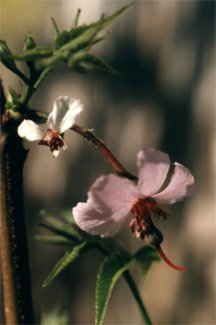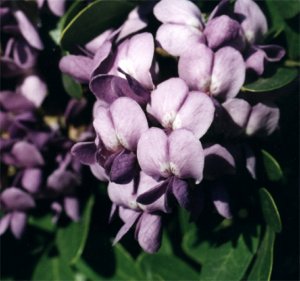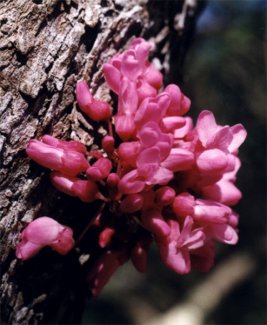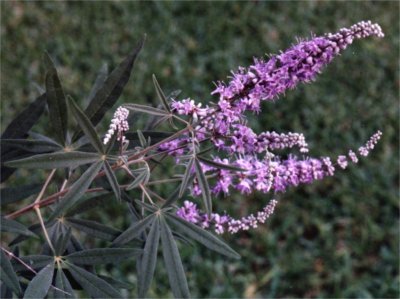Small Trees
by Valerie (July 20, 2000)
|
There are several small to medium trees in our yard that produce pink or purple blossoms. Some have nice fragrances as well. All are well-adapted to hot, dry conditions.
The natural form of a crape myrtle is as a multi-trunk large shrub, but they can get very tall and become trees if they are not severely pruned as is often done in this area. Since we have so many seedling plants, I can experiment with different shapes and have found that in our crowded gardens, a single trunk style works best. Although the large displays of blossoms are familiar to most people, there is an intricate beauty to the individual flowers, which are actually quite complex.
While the crape myrtles bloom for months, at the other end of the spectrum is the Mexican buckeye (Ungnadia speciosa), which blooms for only a short period in the early spring. The flowers are tiny, pretty and fragrant, and appear just as the leaves are starting to emerge. This small tree usually takes on a very sprawling shape, especially if it is growing in the shade. We collected a tiny plant many years ago and put it in a sunny place in the yard. For at least three years it barely grew, so we moved it into the shade of some large live oaks and it promptly doubled in size the first season. It is now about 7 feet tall and fits in well with the other native plants adapted to dry, shady conditions. This tree is not really a buckeye, but the name comes from the large, shiny brown seeds.
Another pink blossoming tree is the mimosa, or silk tree (Albizia julibrissin), which has naturalized throughout the southern U.S. This tree grows very quickly, and the seeds have a high germination rate. The furry-looking pink blossoms appear in late spring and last for a couple of weeks, during which time they have a pleasant, but not overpowering smell. They are one of the few non-red flowers that the hummingbirds seem to relish. The mimosas are one of the last trees to start leafing out in the spring, but once they start, they proceed to grow quite rapidly. The branches prefer to spread outwards, but where they touch another tree or anything else, they grow upwards and avoid overlapping their neighbors. The seed pods that are produced are long and flat, like most legumes or acacias.
The Texas mountain laurel (Sophora secundiflora), also called mescal bean tree, is a slow-growing, evergreen native. After planting the large red seeds (most of which germinated), we discovered that the rate of growth appeared to be about 2 to 4 inches a year. Since we wanted to enjoy the blossoms while we were still alive, we bought a three foot high plant for the yard. After about five years, this tree is now around five feet tall, but does blossom every spring. The flowers are reminiscent of wisteria, hanging in drooping, fragrant clusters of purple that are very attractive to all insects. After the large, gray seed pods form, new growth emerges and is quickly eaten by caterpillars. The caterpillars only attack the largest plant we have and don't bother with the smaller ones, some of which are now almost two feet tall.
Another Texas native is the redbud (Cercis texensis), or Judas tree. Our trees were started from tiny seedlings and some are now about three feet high, having been growing very slowly. The leaves are almost round, and a glossy dark green. There are plenty of mature redbuds around Austin for us to enjoy in the spring and they do produce quite a spectacle of bright pink clusters of blossoms, along all the branches and even on the large trunks of the trees. The redbuds tend to send out additional shoots from their base when they are young.
One more tree that I have enjoyed is the vitex (Vitex agnus-castus). It goes by a number of other names, including chaste tree, chaste berry and monk's pepper, and is native to the Mediterranean area. This multi-trunk shrub can be pruned into a tree shape and has strong smelling foliage, which is interesting and not unpleasant. It puts out long racemes of blossoms, ranging from white to deep purple. The resulting seeds are small balls that are used for various medicinal purposes. |
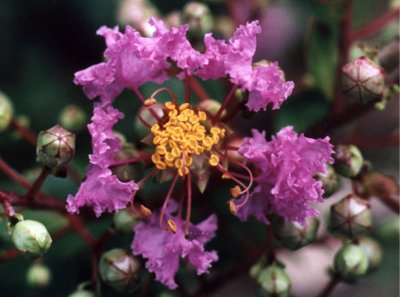 Crape myrtles (Lagerstroemia indica) originated in Asia and are extremely popular trees or shrubs throughout the southern states. They can be pruned into a variety of shapes and their blossoms last longer than any other flowering tree. Colors vary from white through all shades of pink to purple, and the plants are very drought and heat resistant, blooming profusely right through the hottest part of the summer. I bought one small crape myrtle that happened to be on sale at a local nursery. It was only about one foot tall. Now, at least 8 years later, it is about two feet tall. Obviously, this is a miniature variety, which looks just like a bonsai, with a single trunk and small canopy of tiny leaves, blooming with purple flowers late in the summer. All the other crape myrtles in our yard have started from seed, probably from neighbors' plants.
Crape myrtles (Lagerstroemia indica) originated in Asia and are extremely popular trees or shrubs throughout the southern states. They can be pruned into a variety of shapes and their blossoms last longer than any other flowering tree. Colors vary from white through all shades of pink to purple, and the plants are very drought and heat resistant, blooming profusely right through the hottest part of the summer. I bought one small crape myrtle that happened to be on sale at a local nursery. It was only about one foot tall. Now, at least 8 years later, it is about two feet tall. Obviously, this is a miniature variety, which looks just like a bonsai, with a single trunk and small canopy of tiny leaves, blooming with purple flowers late in the summer. All the other crape myrtles in our yard have started from seed, probably from neighbors' plants.
